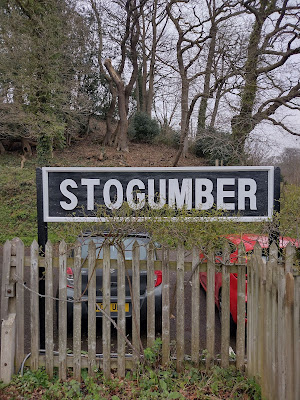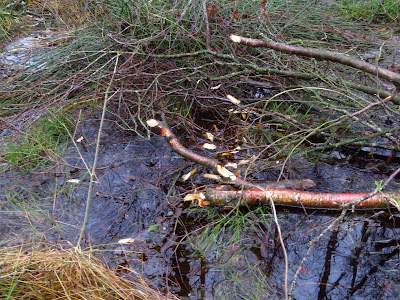In June 1883* the writer Richard Jefferies visited Somerset. There is a little confusion as to why he visited Somerset during the long days of summer given the main work published the following year was a book on red deer, with unsurprisingly the title of Red Deer. This now classic study of deer was a detailed natural history of the landscape red deer roamed over with meticulously researched methods of hunting and the movement and ecology of red deer. Which is why visiting in the summer is a little confusing given the deer hunting season happens during the winter months. To gather the information needed for his book Jefferies spent a few days in Exford with the master of the Devon and Somerset Staghounds Arthur Heal.
I don't wish to go into more detail about the book, as there are better sources than me. You can read more of Jefferies 'Somerset Adventure' and a synopsis of the book via the Richard Jefferies Society Website. Beginning on page 54 of the Societies' Journal Number 39 – 2024
link here
https://www.richardjefferiessociety.org/p/the-richard-jefferies-society-journal.html
My visit to the Quantock Hills this week was to begin researching locations for a maybe fanciful idea of mine of producing a Jefferies in Somerset self guided tour. He covered a large area during the 19 days he spent here, he must have never stopped. But for my visit I began, where else, at the beginning of Jefferies visit, the hamlet of Bicknoller.

My visit coincided with a cool but beautifully sunny January day, in stark contrast with Jefferies summer visit in 1883. On my visit snowdrops were in flower along with early daffodils in St George's churchyard. It really is a peaceful place today, blackbird and great tits were calling in the neighbourhood, but in 1883 it might have been a lot noisier. We forget that when these rural communities were all about farming, a lot of the villagers would have been abroad walking to or working in the fields. Horses pulling carts would be trundling through the lanes, cattle and sheep on the hillsides, tradespeople delivering produce, even poachers at night. The rural landscape is relatively empty today but that is a recent change.
I know Bicknoller only to drive through as it is close to where we come to watch nightjars on a summers evening (no evidence Jefferies saw nightjar here, though I'd be surprised if he didn't do so). This however was the first time I'd explored the hamlet, or maybe it is a small village as it has a pub and a shop? First I walked through the churchyard, and was greeted as I entered through the gate with a riot of spring flowers, quite early considering it is only January. Rooks and jackdaw were noisily prospecting for nest sites above me as I wandered through the gravestones, not looking for anything in particular just something I like to do.
Oddly having bought a pamphlet in the church it failed to say how old it was. The historical record stated that it was a manorial chapel during the reign of Henry 3rd which at some point thereafter became a church. It must be older than that however as the yew tree hard by is reputed to be 1000 years old.

Exiting the churchyard through a gate commemorating Queen Victoria I found a little remembrance area with a few seats. From here, a flask of coffee and my copy of Red Deer by my side, I could observe the toing and froing of Church Lane. Which I have to admit was limited. Two dog walkers, a car and a post van in half an hour. Where was everyone? But I'd particularly come to see Lock's Farm, as it was in 1883. Jefferies stayed for a few days with a Mrs Thorne who leased the farmhouse and was joined by the painter J.W. North. It is not known if Jefferies knew North before visiting but as a result of this visit they became good friends. On this visit I sat quietly looking at what is now a residential house I could imagine Jefferies wandering up and down the lane making notes in his field notebook, chatting to North and hopefully enjoying the clean crisp air of West Somerset. It is known that Jefferies walked up onto the hills behind the house as he mentions Crowcombe and Will's Neck both are nearby and he was a keen walker, though by now he'd become ill with tuberculosis. His arrival at Bicknoller was after alighting from the train at Stogumber. My next destination.

Once part of the Great Western Railway Stogumber is now part of a heritage line, the West Somerset Railway. No trains are running in January but on my arrival I spent a very agreeable half an hour chatting to some of the volunteers there undertaking winter maintenance. Stogumber is around two miles from Bicknoller and how Jefferies got from the station to there is not known. Possibly he walked, possibly he was collected by a horse and cart? We don't know but I like to imagine he walked along the narrow lanes with their tall hedges enjoying a very different landscape to the one he'd left in Sussex just a few hours before.

In 1883 this building would have been the ticket office, now serving as an information point and kitchen (I was informed cream teas are a must in the summer and a new kitchen is planned for 2026). Jefferies would have seen this building, no doubt handing his ticket into the platform attendant as he left. Tangible reminders that although we're nearly 150 year after his visit, the landscape still contained clues and real connections to the past. Did North meet him at the station, pleasant introductions proceeding a friendly walk to his lodgings? All pure conjecture of course.

After a few days in Bicknoller Jefferies headed over to Exmoor staying at Exford. He also visited a number of other places including Dunster, Watchet, Minehead, Horner Wood, Holincote and Porlock where he stayed in the Anchor Inn. Those destinations are for my next visits here. Today however I said my goodbyes to Stogumber and drove up to Crowcombe Gate where the sunshine was strong and the sense of peace exhilarating.
* some sources quote 1882, but later research confirmed 1883.
On line version of Red Deer
https://archive.org/details/reddeera00jeffuoft




















